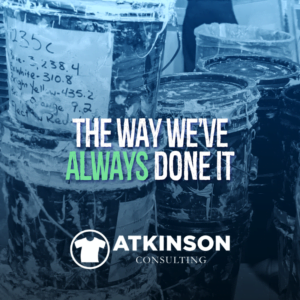I hate to break it to you, but if you are frustrated by the lack of responsible employees in your company, that culture is one-hundred percent your fault.
Not your employees!
Here’s what I mean. Read these examples and tell me if they sound familiar to your shop:
- There seems to be a rash of inexplicable mistakes. People overlook details on the jobs, and keeping quality high seems more difficult than ever before.
- Despite everyone knowing there should be a change made on something to improve it, it never happens because there is that one person that is “uncomfortable with it”. So you keep doing things the slow, antiquated, clunky way.
- Nobody can make a decision without your input. Everyone in your shop seems to stop in their tracks to ask you a question about whatever they are working on, despite handling that same chore for years.
- Someone has verbally stated, “That isn’t my job” when asked to help out.
- Workers only seem to last about a year or two before they quit. When asked why they are moving on, the most common answer is that they “aren’t listened to and don’t feel they get the support they need.”
- Right before any break, lunch or the end of the day a good chunk of your workforce is the bathroom.
- You have department leaders hurling insults and blaming at each other instead of finding solutions to problems. Finger pointing is elevated to a sport.
How to Build a Culture of Responsibility
To get things moving in the right direction, the answer isn’t in how loud you yell at people or threaten them. All that does is breed discontent.
Building a culture of responsibility starts with focusing on three areas in how you manage your business.
Clear Expectations
Simplifying the Rules
Staff Empathy
Managing people isn’t about being a stickler for all the minutiae in a rulebook. Leading people is about understanding and setting them up for success. If you are an owner or a manager of a business, your job is to elevate your staff.
If they fail, you fail. When they win, you win.
It’s as simple as that.
Let’s break down the three areas a bit and see how they could fit into your shop.
Clear Expectations
How are you defining success in your shop?
I ask this because when talking to owners or managers about their crew and what frustrates them they often cite that their shop can’t stay on a predictable schedule in production. It is one of the most common problems I hear about.
A follow-up question to that I ask is usually, “Have you defined what the average day should look like?” For example, if you don’t calculate what is a reasonable expectation of what could be produced in a shift how do you know if you are over or underbooked for the day?
Pushing that idea out even further, does each of your team members know what is expected of them every day? Or, do you have what I call the “You Get What You Get” method of working?
Which is why you finish the day with only a fraction of what needs to ship.
Even if you are a one-person shop, defining what you are doing every day can help you achieve more. The discipline to plan and make that to-do list a to-done list works wonders.
But it is up to you to define that.
Use Numbers
One way is to establish minimum expectations with numbers.
- How many designs should the artist complete today?
- What is the minimum number of screens that need to be reclaimed daily?
- How many impressions per hour should the average auto or manual in your shop run?
- What is the average stitches per minute for each machine in embroidery?
- How many shirts per hour can be pre-treated or produced with your DTG printer?
Benchmark these numbers and set them as a guideline for your shop. While it is good to have the industry averages, you want to use your own set of data. After all, it’s your equipment, customer orders, and employee skill sets that are working in your shop.
Set your own curve and work to improve it. You are in charge of illustrating what success looks like.
Simplifying the Rules
If you want to travel faster, pack light.
That same social rule works in our shops too. Essentially make anything so that there is only one way to do something.
Your Shop Way.
When there is only one way to do any task, you get to create what works for your business. It’s what you train your staff on so they have the core skills they need. Holding people accountable gets easier too, as everyone should be doing things the same way.
This means there is only one way to:
- Quote a job
- Enter an order
- Send off an art approval
- Coat a screen
- Answer the phone
- Prioritize the production schedule
- Purchase inventory
- Authorize overtime
- Mix an ink color
- Stack, fold, and box shirts for an order
- Specify a tonal thread color
- Put a label on a box
- Ask for time off
- Invoice a job
- Organize inventory
There are thousands of these. You get the idea.
Here’s the best part
Your team can help create your “Shop Way” for everything. What are the best practices for your shop with any task?
Have the team members in that department define the rules. You don’t have to do them all at once either.
But as things come up, you need to discuss them and write things down. Make it as simple and easy to understand as possible. Be clear and purposeful with your language.
Use screen captures, and pictures from the shop floor or even videos. “Here’s exactly what you should be doing”, is what you are defining. Get a 3″ ring binder and as you create these add to each department’s section.
Voila! Instant “Operations Manual”.
With this tool, you can train new employees and have the basis for standard operating procedures for your shop for employee performance reviews.
All because in your shop, you are defining what you want to see.
The Culture of Responsibility starts with making it easy to understand how things should be handled.
Staff Empathy
Good culture in a business thrives on empathy.
Does your company demonstrate that you care about your staff as people?
How would you rate your overall sense of teamwork?
In the day to day, are workers trying to help those downstream from them? Or do they pass the buck and let someone else take care of a problem?
Here’s where it shows up the most in your shop:
- What type of confusing mess does the art department get for orders? Are instructions clear so the file can be constructed easily?
- People stand around or start chatting when there is a lull in the workday. Meanwhile, twenty feet away another work team is struggling to finish their tasks on time.
- Compensation increases are based on attendance and length of service more than actual daily performance.
- The eternal front office vs back shop “they don’t understand what we do all day” feud.
- Managers not understanding the people they supervise. Relationships are built on trust and understanding. Not with the volume of your words.
The Work-Family
The third leg of the Culture of Responsibility stool is constructed on this sense of empathy towards others. When we see others on our team as people or our “work family” we won’t want to let them down. In fact, we might go out of our way to help them.
Making someone else’s job easier if there is a free moment isn’t going to show up on a resume. But it is something you can search for on that page.
Look to see if the person has a background of belonging to a team. How did they accomplish their goals? Part of “Hire for Attitude, Train for Skill” comes with seeking out that empathy gene. It shows up as part of belonging to a team.
Have they worked on a team in another business? Did they play sports in college or high school? Did they serve in the military? Ask questions about those experiences to pull out a story of how that person views teamwork.
Putting It All Together
This is a crazy industry.
Lots of moving parts, challenges, and even some new disruption heading our way. So in thinking about how to put these three ideas together to build a better Culture of Responsibility, let’s outline some best practices that you can use in your shop today.
First, start with being transparent and authentic. Get your staff on board for the future by embracing their ideas in discussions about how to make the shop work better. If two heads are better than one, then how would twenty-five or thirty fit in?
Find out what seems to be confusing or distracting.
Simplify and add clarity to everyone’s day. When someone knows what’s expected of them, and they have the right training to perform, that’s when speed and quality show up to dance together.
Also, be sure you understand how the concept of time fits into all of this.
Not just when something is due, but when should it be started in the first place?
I’ve run shops where we produced around 40,000 orders a year without ever having a morning production meeting. This was due to a high level of teamwork, critical job training, and everyone understanding how to find the answers they need to do the next tasks.
When Things Breakdown
Creating that culture is hard. It is definitely an on-purpose thing.
Somewhere along the way, there may be a breakdown. When that happens try to see if you can pinpoint that to one of three things:
Lack of Expectations. Did they know what they were supposed to do?
Confusing Rules. Was something not explained well, or even defined at all? What should happen next time?
Zero Empathy. Where was teamwork in this? How are we not relating to each other as people?
Bring your team together and discuss. Ask questions.
The Culture of Responsibility that you seek doesn’t simply show up one day like a stray cat. You have to create that with actions and hard work.
“You cannot escape the responsibility of tomorrow by evading it today.” – Abraham Lincoln
“The price of greatness is responsibility.” – Winston Churchill
“Leadership is about taking responsibility, not making excuses.” – Mitt Romney
Grab the “Shop Basic Info Pack” eBook Today!

One thing that helps with employee accountability is using a clearly-written employee handbook.
One of the sections the eBook, “Shop Basic Info Pack” is a 53-page template that you can customize for your shop. That’s right. In about five or ten minutes worth of customizing, you can have an employee handbook that is perfect for your shop.
This template is packed with everything you need to organize the clear expectations for what your employees need to know.
Along with the Employee Handbook template are also two shop Business Plan templates that are custom written for the decorated apparel industry, a robust section on Branding, and also a Production Log Dashboard System to help you monitor your daily screen-printing production.
Click here and buy the eBook. Value priced at $49.





